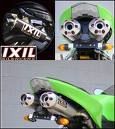Saturday, December 29, 2007
Blow the ZZR 1400
Do it like you do it to me (I'm burning up)
Do it like you do it to me (it's not enough)
Do it like you do it to me just open up
Don't you know how much I want ZZR 1400
he3...Nelly Furtado - do it, lyrics editted...
Kawasaki Z1000: MD Ride Review
 are all the rage, and Kawasaki's brand new Z1000 breaks new ground in a couple of areas (more about that later). We just spent several days testing a 2003 Z1000 (the black model -- the bike also comes in orange, as illustrated in some of the photos). Let's talk first about the technical aspects of this new bike, because that is a big part of the story.
are all the rage, and Kawasaki's brand new Z1000 breaks new ground in a couple of areas (more about that later). We just spent several days testing a 2003 Z1000 (the black model -- the bike also comes in orange, as illustrated in some of the photos). Let's talk first about the technical aspects of this new bike, because that is a big part of the story.In the United States, at least, the naked bike category has been the "weak sister" for most manufacturers. Old, already-paid-for components have been the rule. Indeed, interest in this category, and the desire to throw current technology at it, has only arisen on the manufacturer's side in the last few years. Yamaha's FZ1, with its R1 motor and brakes, might be considered the most high-tech bike in the category as of the 2002 model year. The Kawasaki Z1000 moves the bar forward from there.
While sharing the current engine with a manufacturer's flag ship, open-class sportbike is impressive (as the FZ1 does), the Z1000 actually has a higher spec engine than Kawasaki's open-classer, the ZX-9R. The Z1000 takes the ZX-9R engine and increases its displacement to 953 cc with a 2.2 mm larger bore. Additionally, the carbureted ZX-9R motor gets fuel injection in the Z1000 (featuring 38 mm throttle bodies, with sub-throttle valves for smoother operation).
The Z1000 engine is mounted in a rigid diamond frame as a stressed member. A detachable right front-top engine mount eases maintenance.
Su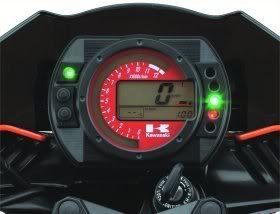 spension consists of an inverted 41 mm fork adjustable for both preload and rebound, with a rear shock also adjustable for preload and rebound. The 17 inch rims on the Z1000 come straight off the ZX-9R, and our test unit featured excellent Bridgestone BT-020 tires (including a huge, 190 section rear).
spension consists of an inverted 41 mm fork adjustable for both preload and rebound, with a rear shock also adjustable for preload and rebound. The 17 inch rims on the Z1000 come straight off the ZX-9R, and our test unit featured excellent Bridgestone BT-020 tires (including a huge, 190 section rear).
The front brake features 300 mm discs gripped by the same four-piston calipers found on the ZX-9R. The rear brake is a smaller, single-disc set-up.
The Z1000 gets the same instrument technology featured on the new Kawasaki sportbikes, which results in an extremely light, compact instrument cluster with a bar-type LCD tachometer and digital LCD speedometer. Other information provided by the instruments include temperature, clock, trip meter, fuel gauge and a gaggle of indicator lamps.
The styling of the Z1000 is, simply put, stunning. The bike is impressive in pictures, but it is even more so in the flesh. The bold design of the Z1000 isn't an aberration -- expect much more to come from Kawasaki.
The Z1000 is a little soft right off idle, but pulls smoothly into a meaty mid-range and a very serious top-end rush. Overall, the Z1000 is extremely fast -- probabl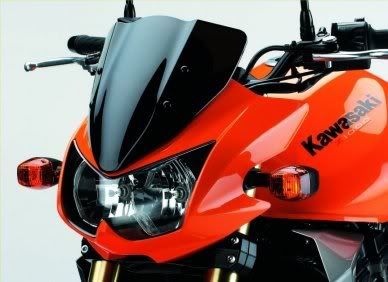 y a close contender with Yamaha's FZ1 in a drag race.
y a close contender with Yamaha's FZ1 in a drag race.
The fuel injection delivers that power smoothly and progressively -- utilizing Kawasaki's latest fuel injection design (also featured on the new ZX-6R, for instance).
The Z1000 puts more vibes through the bars and the pegs than some of its competitors -- reflecting the fact that the engine is directly bolted to the frame as a stressed member. We didn't find the vibration annoying, however, but it is there. We did have an annoying buzz from the clutch lever at around 5,000 rpm (something that could probably be fixed with a three cent washer). In the mid-range, the mirrors were also quite buzzy.
The chassis of the Z1000 feels sport bike stiff, and the bike handles well. The leverage of the wide, dirt bike-styled bars provide easy turn-in, yet the bike remains very stable (even at high speeds).
http://www.motorcycledaily.com/17february03kawasaki2003z1000.html
So, you think the ZZR-1400 is ugly?
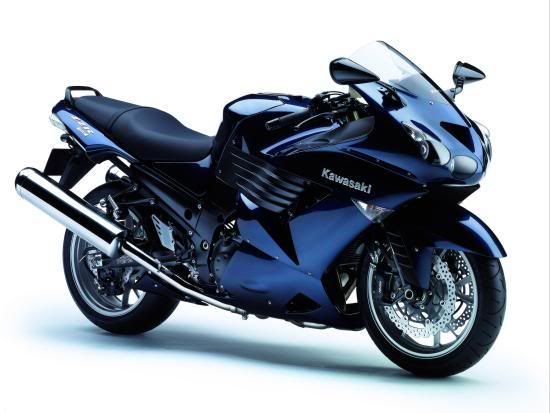
In my NEC Preview article, I may have given the impression that I was a fan of Kawasaki's ZZR-1400. And that's because I am - I love it. I had literally no replies from anyone agreeing with me, and 3 replies from people who completely disagreed. One comment suggested I'd been given one by Kawasaki, hence why I am so positive about the ZZR (Kawasaki, if you're reading this, I have cleared a large ZZR-1400 shaped space in my back yard).
I understand that it may not be the prettiest thing out there, but don't stare at it and look for sportsbike like qualities, like a tiny front end, pert little seat, or manageable size. Compare it to a sportsbike and it doesn't fair well aesthetically, I'll admit it.
It's the concept that I love, because in 2000 all manufacturers signed an agreement limiting bikes to a 'not exactly slow' 186mph. This came about after the launch o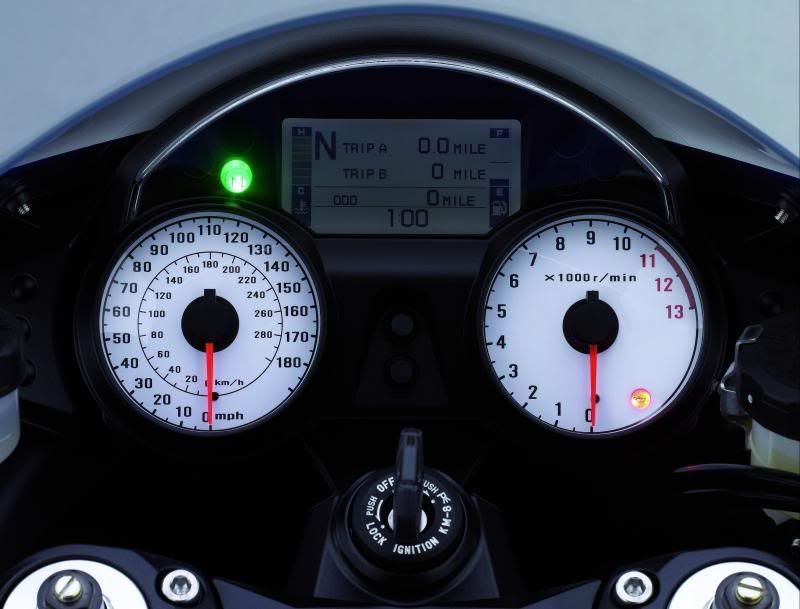 f Suzuki's 1298cc Hayabusa, which - it was claimed - could do 200mph. It never quite managed it but at the time, the Hayabusa was the fastest of them all.
f Suzuki's 1298cc Hayabusa, which - it was claimed - could do 200mph. It never quite managed it but at the time, the Hayabusa was the fastest of them all.
The latest GSX-R1000, is quicker through the 1/4 mile than the 'Busa, faster off the line and will pull to the limiter in top, leaving the 'Busa behind. For me, that marks the end of the mighty Hayabusa's significance. It can no longer claim to be the fastest production bike, or king of the traffic light GP. And with it, the point of these hypersports tourers faded.
Until now that is, and that's why the ZZR-1400 brings a smile to my face. Rumours of 200bhp at the rear wheel from its brutal 1352cc engine make the hairs on the back of my neck stand up. It's totally pointless but in a way that's the point. No-one needs a 'tourer' that shreds rear tyres in 2000 miles. No-one needs anymore than 186mph, or anything close to that but just to know that Kawasaki are prepared to produce the ZZR-1400 marks them up a notch in my book.
While our country is obsessed with being a few mph over the speed limit and more and more bikes feature 'safety' in their sales pitch (ABS on sportsbikes anyone?) Kawasaki has - in my opinion - said in a big, bold Pearl Meteor Grey or Candy Thunder Blue statement "Have some of that!"
It's interesting to note the ZZR-1200 has been discontinued. Perhaps we should have guessed that something bigger and better was in the pipeline. I've put the ZZR-1200 up against the ZZR-1400. That 14 front end is beautiful. To me, it looks like a basking shark; it's aggressive yet it looks lazy with it. The ZZR-1200 didn't know what it wanted to be, the 14 looks like it's on a mission.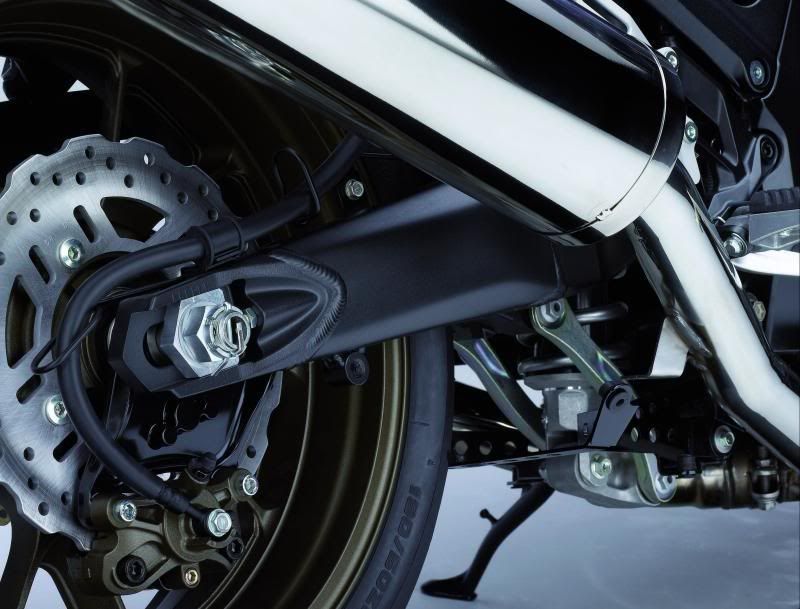
When you look at it side on, the old 1200 looks fickle, disjointed and bulky. The ZZR-1400 doesn't look svelte, I know, but it looks more compact and complete. It doesn't look like the square-looking ZX-12R - which is a good thing - and it shares some family characteristics with the current ZX-10R and 6R.
From the rear, the ZZR-1400 beats the ZZR-1200 hands down too. It's just not ugly; it shares a similarity with the 6R, 10R and Z750. It's not as slim as a modern Blade for instance, but the ZZR-1200 looks bug-eyed from the front and behind and the ZZR-1400 is a drastic improvement on the ZZR series to date.
I can only hope the ZZR sells well for Kawasaki and this encourages more manufacturers to get back to the CAD software and work out other ingenious ways to house stupidly large, pointlessly powerful engines in-between two wheels.
http://www.visordown.com/articles/view/so_you_think_the_zzr_1400_is_ugly/27.html
GTR 1400 Video Commercial
You want to see the specifications of GTR 1400. This video is the answer. So, you think GTR 1400 is ugly?
Friday, December 28, 2007
Take A Look To GTR 1400 [2008]
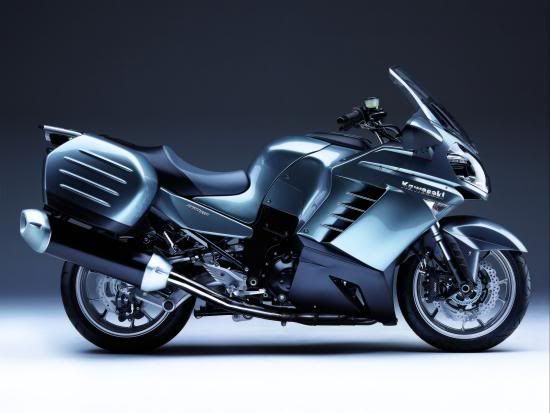 oming. You will just have to wait another year to purchase THE Transcontinental Supersport.
oming. You will just have to wait another year to purchase THE Transcontinental Supersport. Kawasaki have their own idea of touring. The result is the 1400 GTR (model year 2008) representing an entirely new genre of high-performance motorcycles: the Transcontinental Supersport. Starting with breathtaking engine performance, impeccable handling and slim riding position, the new GTR adds touring features that make it the most impressive long-distance, high-speed machine on the market today.
As another flagship-level model, it was essential for the 1400 GTR to remain true to the Kawasaki brand. Thanks to first VVT (Variable Valve Timing) system in its class the GTR’s engine performance is just as remarkable.
Ultra-low-rpm and mid-range torque output is simply breathtaking, as is the effortless acceleration from any speed. 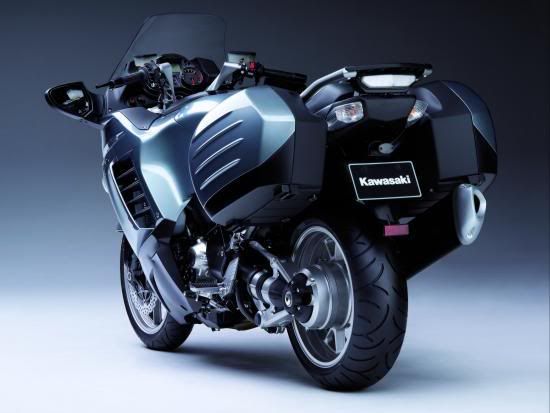 Thanks to the drive-line lash reducing Tetra-Lever shaft drive system power delivery to the rear wheel is so smooth and so direct that it gives the same natural ride quality as a chain.
Thanks to the drive-line lash reducing Tetra-Lever shaft drive system power delivery to the rear wheel is so smooth and so direct that it gives the same natural ride quality as a chain.
Like its engine, the GTR’s chassis is based on that of the ZZR1400.
While modifications were made for touring comfort and equipment, and the riding position has been adjusted, sport riding quality from Kawasaki’s unique aluminium monocoque frame remains uncompromised. The GTR offers a bank angle on par with the ZZR1400, with excellent steering feedback from the rigid chassis, inverted fork and other high-spec running gear.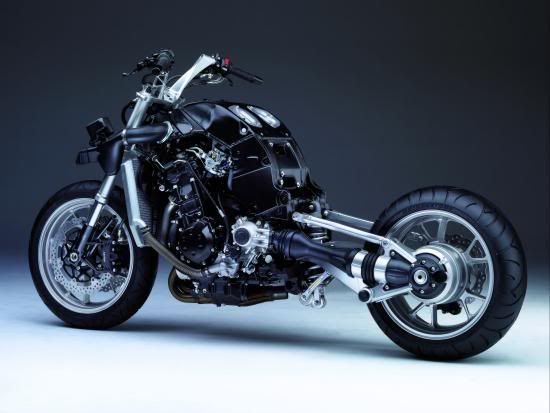
Combined with a high-spec ABS brake package delivering supersport-level braking performance, the world’s only “monocoque tourer” delivers handling unrivalled in this class.
In addition to the sporting performance, the new GTR has the functionality of a Grand Tourismo machine. Features include an electrically adjustable windscreen, standard panniers, tyre pressure sensors, KI-PASS, the first smart key ignition system in its class, and an AC power outlet located under the cockpit.
For those riders who cross countries and continents the way others cross the city, the Kawasaki 1400 GTR offers more excitement than anything else in its category.
http://www.motorcyclists-online.com/o1_375_First-look--2008-Kawasaki-GTR-1400.html
Crazy Day With ZX10-R
Speed, speed and speed again. You really enjoy this video. When we're on motorbike, we feel freedom which is like a bird in the land. No limit. Just do it...
2007 Kawasaki Ninja ZX-10R Review
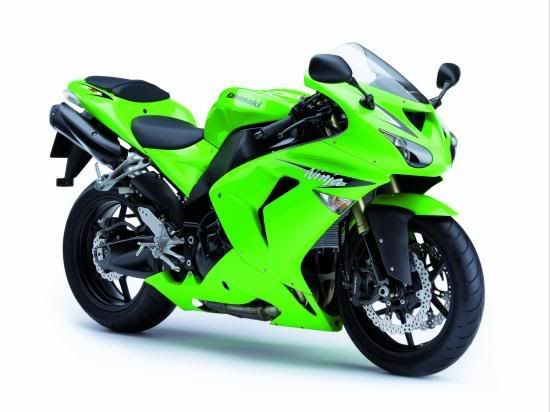 Kawasaki’s 2007 Ninja ZX-10R combines awesome power with agility and grace. Racetrack performance with real-world stability.
Kawasaki’s 2007 Ninja ZX-10R combines awesome power with agility and grace. Racetrack performance with real-world stability.It didn’t take long for Kawasaki’s original Ninja ZX-10R sportbike to earn a reputation for dominating horsepower and excellent handling. The second generation ZX-10R continues that domination, featuring a racetrack-focused chassis and more horsepower than any other open-class supersport. Street riders and backroad enthusiasts will also appreciate the ZX-10R’s solid stability and predictable handling, thanks to its superb engineering.
With excellent mid-range power and a screaming top-end, the ZX-10R’s ability to accelerate out of corners is aided by its linear power delivery and enhanced traction provided by its long swingarm. This makes it easier for riders to capitalize on the ZX-10R’s horsepower advantage.
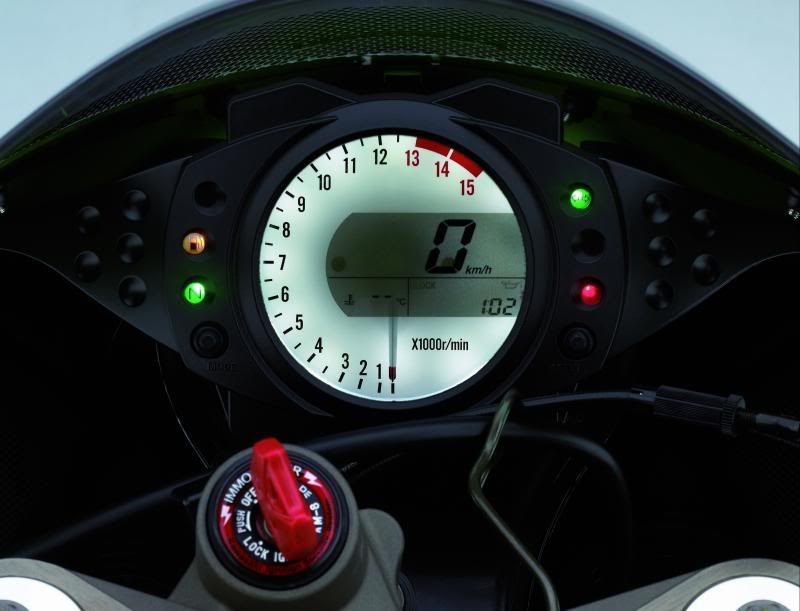 Designed for the rider who feels at home in racing leathers, the ZX-10R delivers unmatched track performance. A short wheelbase coupled with a long swingarm gives the bike outstanding maneuverability and excellent rear wheel traction. Even more to the liking of experienced racers, the Ninja’s concave tank top and the relationship between pegs, handlebar and seat only magnifies its appropriateness for the track.
Designed for the rider who feels at home in racing leathers, the ZX-10R delivers unmatched track performance. A short wheelbase coupled with a long swingarm gives the bike outstanding maneuverability and excellent rear wheel traction. Even more to the liking of experienced racers, the Ninja’s concave tank top and the relationship between pegs, handlebar and seat only magnifies its appropriateness for the track.
The ZX-10R shines in the upper speed ranges, thanks to a fairing, seat cowl, and dual under-seat exhaust system which are designed for slippery aerodynamics and a clean look that sets it apart from its competition.
When arriving at the next corner faster than the competition, the rider needs brakes that are up to the task. Not only does the ZX-10R offer impressive stopping power from its dual floating 300mm petal discs, radial-mount four-pad/four-piston calipers and radial-pump master cylinder; it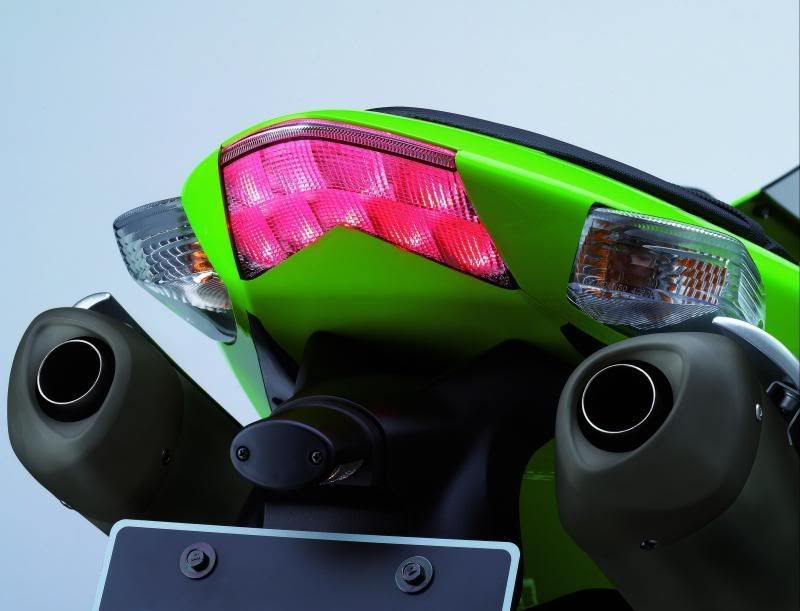 also provides precise modulation and a consistent feel at the brake lever.
also provides precise modulation and a consistent feel at the brake lever.
The ZX-10R features an adjustable, race-spec, twin-tube, ?hlins steering damper with relief valve. The twin-tube damper uses the second tube like a reservoir tank to help ensure consistent performance under demanding race conditions.
At its core, the Ninja ZX-10R is a motorcycle built for the accomplished rider who can fully appreciate its capabilities—whether put to the test at a racetrack, or merely the focus of bench-racing conversation. It is, by all standards, the embodiment of the ultimate superbike.
http://www.arabia.msn.com/Autos/Motorcycles/May07/KawasakiNinja.aspx
The Appearance of ZX10-R
This is just a simple video. It shows you the bodykit, engine sound and the exhaust. ZX10-R is a marvellous bike.
Wheelie Style - using ZX10-R
Maybe, some of you feel that it is hard to you to make wheelie by a motorbike because it is not as easy as usual. Wanna learn the best way to wheelie?. I think this video may help you. ENJOY...
Thursday, December 27, 2007
ZX14R - Super Streetbike
Here, i put some video for your reference. zx14r is the most super streetbike due to its perfomance which is higher others. with a big horsepower engine, zx14r become the mini monster in the road.
notice: sorry, this video is not in english. however, i think you can understand just by looking at this video.
2008 Kawasaki ZX-10R motorcycle revealed
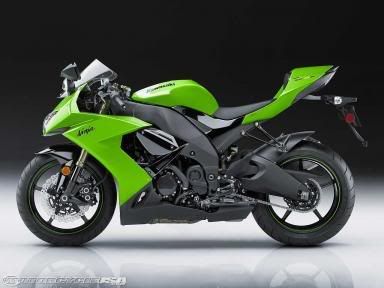 powerful electronic brain that contains more than 500 engine-control maps which govern some sort of anti-wheelspin program that Kawasaki says we shouldn’t describe as traction control.
powerful electronic brain that contains more than 500 engine-control maps which govern some sort of anti-wheelspin program that Kawasaki says we shouldn’t describe as traction control.“It curtails sudden spikes in engine speed,” explained Kawasaki’s U.S. Product Manager, Karl Edmondson in Qatar. But he made sure to add that “it’s not a traction control system.”
Basically, the sophisticated ECU retards ignition timing when it senses wheelspin via a myriad of sensors such as engine speed, throttle position, vehicle speed, gear position, , cam position, etc. We were told that the system doesn’t engage when the throttle is twisted hard. Rather, it will engage only when rear-wheel slip is detected at neutral throttle openings. Big K reps note that the KIMS settings are for high-level riders pushing the limits, but we might envision a circumstance in which KIMS might prevent a spill in low-traction surfaces on the street. .
"The 2008 is smaller, skinnier and sharper..."
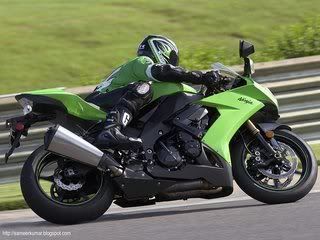 The’08 is smaller, skinnier and sharper, sized almost like a 750-sized machine. Most pleasing is that it’s much more reactive to rider inputs, responding sharply and with total cooperation. And despite its incremental weight increase (largely the result of the controversially styled exhaust that includes all the emissions B.S. such as three catalyzers and a large under-engine pre-chamber), it definitely feels lighter. Positioning the bulk of the side-mount stainless steel exhaust system’s weight (and titanium muffler) nearer the bike’s roll center – as opposed to the previous dual underseat cans – must be a factor.
The’08 is smaller, skinnier and sharper, sized almost like a 750-sized machine. Most pleasing is that it’s much more reactive to rider inputs, responding sharply and with total cooperation. And despite its incremental weight increase (largely the result of the controversially styled exhaust that includes all the emissions B.S. such as three catalyzers and a large under-engine pre-chamber), it definitely feels lighter. Positioning the bulk of the side-mount stainless steel exhaust system’s weight (and titanium muffler) nearer the bike’s roll center – as opposed to the previous dual underseat cans – must be a factor.
All previous ZX-10s were never short on power, and this year’s model is no exception. According to Kawasaki-supplied data, this latest Ninja boasts an increase in crankshaft horsepower of 6, now up to 179 horsepower at 11,500 rpm compared the paltry 173 hp of the previous iteration. With the assistance of force-fed air to the pressurized airbox, we’re told it churns out 189 hp at its peak. We expect 160-plus at the rear wheel. A maximum torque figure of 83 ft-lbs is achieved at 8700 rpm
A minor nit to pick is a slightly mushy feel at the lever due to the use of rubber brake lines. Feel could undoubtedly be more direct with the addition of braided steel lines. A Kawi rep told me that steel lines aren’t used because the sharper initial bite could be a bit much for the average street rider. For example, the ABS-equipped Z1000 sold in Europe has steel hoses, but the version without ABS has spongier rubber lines. Gotta protect ourselves from ourselves…
It was difficult to judge the ZX’s suspension at Losail because of the perfectly smooth GP-level surface, but it’s worth noting that the bike I shared with two other journalists at the track was able to be set up optimally despite rider weights that varied by more than 40 pounds. Partial credit goes to a new rear shock that incorporates separate high- and low-speed compression damping circuits and a 43mm Kayaba fork that uses a low-friction Diamond-Like Carbon (DLC) coating on the inner fork tubes. And it didn’t hurt to have legendary AMA Superbike wrench Joey Lombardo performing the knob twiddling in my pits!
But, really, these aren’t problems that would prevent me from considering owning such a potent package. It’s sure to be as fast as anything, it’s way more controllable than you’d expect from a literbike, and it’s a thoroughly developed instrument that makes its rider look like a hero.
Kawasaki’s got a winner with this green machine, and it’s going to take an amazing new CBR from Honda run with this stellar motorcycle.
http://www.motorcycle.com/manufacturer/kawasaki/2008-kawasaki-zx10r-70426.html
interior of kawasaki zx6r
From the video above, you can see the interior of kawasaki zx6r and study how it's working. it is a marvellous technology. explore the engine, clutch, brakes, gearbox, motor, tank and exhaust system. huh, no wonder it can speed to 100kmh within a few second.
Kawasaki's ZX-6R inspires confidence
 Like the ZX-10R, the NINJA ZX-6R is oriented toward serious sport riding and track performance. It features ultra-aerodynamic bodywork with Ram Air, GP-style swingarm, under-seat exhaust system, six-spoke wheels, petal-style disc brakes, inverted forks and a powerful engine that will leave riders itching to find their local twisty highways.
Like the ZX-10R, the NINJA ZX-6R is oriented toward serious sport riding and track performance. It features ultra-aerodynamic bodywork with Ram Air, GP-style swingarm, under-seat exhaust system, six-spoke wheels, petal-style disc brakes, inverted forks and a powerful engine that will leave riders itching to find their local twisty highways. Along with its racing-homologated sibling, the ZX-6RR, the new NINJA ZX -6R is the most aerodynamically efficient sportbike Kawasaki has ever created – even more streamlined than the leading-edge ZX-10R. Specifically, the new fairing helps to divide the air stream farther ahead of the bike; by moving the “bubble” of still air farther forward in the cockpit, the rider experiences less buffeting around the head and shoulders.
The point of convergence – where the divided air streams comes together behind the rider – is critical to aerodynamic efficiency, so Kawasaki engineers designed the tail section to smoothly blend the air together while minimizing turbulence. The result is quicker roll-on acceleration and higher top speeds at the race track, as well as enhanced rider comfort and control.
The new body work also includes a ZX-10R-style central Ram Air duct and a flush-surface LED tail light, which makes the ZX-6R more visible to drivers of other vehicles. It also features an aerodynamic ZX-10R-style front fender for a strong NINJA family resemblance.
 From the cockpit, the NINJA ZX-6R rider will notice several more leading-edge features that put this bike at the forefront of design and performance. Foremost is the new split-seam fuel tank/airbox cover. The rear half is the actual fuel tank, designed to fit neatly between the frame spars and down behind the engine’s fuel injection system, while the front half covers a new, quick-access air box. By centralizing the fuel mass near the center of the bike, chassis responsiveness is enhanced – weight transfers from turn to turn are lighter, and the chassis is exceptionally stable under acceleration and braking.
From the cockpit, the NINJA ZX-6R rider will notice several more leading-edge features that put this bike at the forefront of design and performance. Foremost is the new split-seam fuel tank/airbox cover. The rear half is the actual fuel tank, designed to fit neatly between the frame spars and down behind the engine’s fuel injection system, while the front half covers a new, quick-access air box. By centralizing the fuel mass near the center of the bike, chassis responsiveness is enhanced – weight transfers from turn to turn are lighter, and the chassis is exceptionally stable under acceleration and braking.
The advanced split-seam design also enabled engineers to make the airbox larger, thus enhancing engine performance. It also makes filter access quick and easy. Plus, a depression in the top of the fuel tank enables the rider to tuck in for improved aerodynamics.
The final tribute to aerodynamic efficiency is the new under-seat muffler, which gives the NINJA ZX-6R a slim, racy look.
Exhilarating Power and Performance
No sportbike can garner mass approval on good looks alone, and here again, the NINJA ZX-6R sets new standards of performance for the middle-weight class. For that, the engine includes a new cylinder, new cylinder head, and 38mm oval-shaped sub-throttle valves fed by twin injectors and redesigned Ram Air.
The NINJA ZX-6R utilizes oval-shaped sub-throttle technology. Combined with the improved Ram Air design, the oval-shaped throttle bodies increase airflow without making the fuel delivery assembly wider – intake efficiency is improved nearly 20 percent while helping to maintain a slim chassis profile.
Larger intake and exhaust valves, revised cam profiles and an exhaust valve integrated with the muffler improves low and mid-range response of the 636cc engine.
Also, the engine control unit has more memory for controlling the exhaust valve and second set of fuel injectors. Plus, the radiator is 40mm taller and features more-tightly packed cores for increased cooling capacity.
The NINJA ZX-6R features a more durable, smoother-shifting six-speed transmission, and includes a taller third gear ratio. It also utilizes a back-torque limiting clutch, which helps to reduce rear-wheel hop that may occur when downshifting a high-rpm.
The matte-black aluminum frame features a shortened the wheelbase and the swingarm pivot point has been moved forward. Combined with a longer, braced aluminum swingarm, the new chassis gives the NINJA ZX-6R improved cornering performance and high-speed stability.
The fully adjustable Showa fork delivers improved ride quality and outstanding cornering performance. At the rear, new UNI-TRAK® linkage ratios provide more linear action, and new shock settings improve ride quality and track performance.
Radial-mounted, four-piston front brake calipers deliver exceptional feel and performance; four independent brake pads are used – one for each piston – for more even wear and improved heat resistance. The 300mm petal-style front discs are 5.5mm thick for high heat capacity and the front brake master cylinder uses direct action for better rider feedback. Also, the caliper for the 220mm rear disc brake mounts directly to the swingarm, negating the need for an independent brake tie-rod.
The NINJA ZX-6R rides on light, six-spoke wheels shod with 120/65ZR17 front and 180/55ZR17 rear tires for exceptional cornering performance.
The Cockpit
The riding position is also based on the NINJA ZX-10R. By pulling back the steering head assembly, the distance between the handlebars and footpegs is reduced, which provides the rider with an idealized position for performance riding. Combined with the new frame, seat and fuel tank, the rider sits “in” the bike, rather than “on” it.
The NINJA ZX-6R’s racing-style instrument panel features a bar-type LCD tachometer, digital LCD speedometer, stopwatch-style lap timer and adjustable shift indicator lamp, which includes Off, Low and Bright settings. A digital temperature gauge, clock and tripmeter are also included.
http://www.diseno-art.com/encyclopedia/vehicles/road/bikes/Kawasaki_ZX6R.html
zx12r accelerates to 300kmh
See....how fast zx12r. it can accelerates up to 300kmh. wowwww...amazing. i watched this video before but i think it's just a blast. however, when i explore more about zx12r, it's true that it can speed up to 300kmh. it's marvellous.
zx12r [road test]
 The acceleration of the ZX12R is nothing short of incredible. In true Kawasaki tradition this engine, which produces over 175BHP is more than ready to take on all comers, anywhere, anytime. With truckloads of power and torque on tap, the ZX-12R accelerates out of corners at an incredible pace, the huge 200 section rear tyre digging deep to put all that power down to the road. Its deep and powerful sound that accompanies the rapid acceleration is the acoustic complement to the wind noise ripping through your helmet as you gain momentum at a frightening pace. Passing cars? No problem. Twist the throttle in any gear and reach Warp factor 12 a few moments later, downshift and nail it and you may see God! I quickly found the arm-straightening power intoxicating and difficult to resist, so much so that on a quiet stretch of unrestricted Autobahn I was alarmed when glancing down at the speedo to see a reading of 190mph, and I had only just changed up to 6th! At these speeds, the excellent wind protection of the big ZX12R was much appreciated.
The acceleration of the ZX12R is nothing short of incredible. In true Kawasaki tradition this engine, which produces over 175BHP is more than ready to take on all comers, anywhere, anytime. With truckloads of power and torque on tap, the ZX-12R accelerates out of corners at an incredible pace, the huge 200 section rear tyre digging deep to put all that power down to the road. Its deep and powerful sound that accompanies the rapid acceleration is the acoustic complement to the wind noise ripping through your helmet as you gain momentum at a frightening pace. Passing cars? No problem. Twist the throttle in any gear and reach Warp factor 12 a few moments later, downshift and nail it and you may see God! I quickly found the arm-straightening power intoxicating and difficult to resist, so much so that on a quiet stretch of unrestricted Autobahn I was alarmed when glancing down at the speedo to see a reading of 190mph, and I had only just changed up to 6th! At these speeds, the excellent wind protection of the big ZX12R was much appreciated.
It’s on the twisting A & B roads that big, powerful bikes like this are usually most challenged, but even though the ZX12R tips the scales at a mighty 213kg (that’s 43kg more than a GSX-R1000), the ZX carries the extra bulk well. Steering rake has been increased to a rather steep 23.5 degrees, and the fork offset has been reduced, thus providing improved, and much quicker turn-in characteristics. The changes made to the 12R chassis revolved around shifting the weight forward in the interest of keeping the front end planted, and it seems to have worked since it absolutely no problems running alongside and in front of its track-happy lightweight brethren.
In the interest of keeping that awesome power to a manageable and more useable level, the crankshaft weight has been increased by 2kg, which is partly responsible for the smoother delivery. A new oval-shaped pulley operates a bank of 46mm throttle bodies, helping the rider feed fuel gradually to give sm oother throttle response when first cracked open. The new ram-air intake has now been cleverly incorporated into the front cowling to create a more aesthetically pleasing nose, while the 30% increase to its surface area makes the system more functional than the snorkel like intake it replaces. The new bike thus has an absolutely linear power delivery and has got rid of that slightly annoying ‘hunting’ feeling when cruising at normal speeds. Although the bodywork on the new bike has only been slightly tweaked, it does benefit from a one-point reduction in drag coefficient letting it slide through the air easier (as if it needs to!). The 12R still retains the wings on the lower fairing, which effectively do nothing, but they do give you something to talk to the spectators about. “Yes sir, those help to keep the bike stable at speeds over 150mph, just like a Porsche rear wing really.”
oother throttle response when first cracked open. The new ram-air intake has now been cleverly incorporated into the front cowling to create a more aesthetically pleasing nose, while the 30% increase to its surface area makes the system more functional than the snorkel like intake it replaces. The new bike thus has an absolutely linear power delivery and has got rid of that slightly annoying ‘hunting’ feeling when cruising at normal speeds. Although the bodywork on the new bike has only been slightly tweaked, it does benefit from a one-point reduction in drag coefficient letting it slide through the air easier (as if it needs to!). The 12R still retains the wings on the lower fairing, which effectively do nothing, but they do give you something to talk to the spectators about. “Yes sir, those help to keep the bike stable at speeds over 150mph, just like a Porsche rear wing really.”
The dash has a digital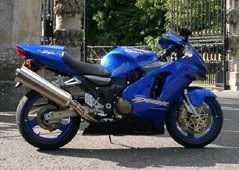 display with the fuel gauge, two trip meters, an odometer and a clock, all of which are handy stuff no matter who you are or where you’re riding. The traditional analogue tacho and speedo look good and are easy to read whether you’re tucked in or cruising along. Changing gear on the ZX couldn’t be any easier with its 6-speed box being as smooth as anything I have ridden. The improved characteristics come courtesy of an increased shaft diameter that reduces clearance between the gear selectors for a more precise feel. With the exception of one false neutral between 4th and 5th, the gearbox was fantastic throughout our test proceedings. The clutch was also easy to operate, with a relatively light and positive action, and the lever pull wasn’t tough enough to warrant any complaints
display with the fuel gauge, two trip meters, an odometer and a clock, all of which are handy stuff no matter who you are or where you’re riding. The traditional analogue tacho and speedo look good and are easy to read whether you’re tucked in or cruising along. Changing gear on the ZX couldn’t be any easier with its 6-speed box being as smooth as anything I have ridden. The improved characteristics come courtesy of an increased shaft diameter that reduces clearance between the gear selectors for a more precise feel. With the exception of one false neutral between 4th and 5th, the gearbox was fantastic throughout our test proceedings. The clutch was also easy to operate, with a relatively light and positive action, and the lever pull wasn’t tough enough to warrant any complaints
The Mega Ninja can be thrashed (if you can) down any A or B road or it can help you tap into terminal velocity on an unrestricted bit of German Autobahn near you.The ZX-12R is an excellent mix of touring comfort and sports performance. However, inexperienced riders seriously need not apply. But if you've got a few years riding under your belt, the ZX12R is the wild card ride for you. The biggest cost to any ZX12R riders may be their licenses!!
http://www.motorbikestoday.com/reviews/Articles/ZX12R.htm
Sunday, December 16, 2007
NINJA ZX 14 R
 September 23, 2005 For several years now, the 178bhp Kawasaki ZX12 has had the most horsepower of any production motorcycle, though it has played second fiddle to the 175 bhp Suzuki GSX1300 Hayabusa (named after the Japanese Peregrine falcon, one of the few animals on the planet which can travel at 300km per hour which it does during a dive) because the Hayabusa has a higher top speed – the Suzuki’s aerodynamics enable it to more than make up for the slight horsepower deficit and it has now held the title of the world’s fastest production motorcycle for six years since it launched. The Hayabusa’s top speed as measured by the Guiness Book of Records is 317 km/h. But Kawasaki’s just announced ZX14 company flagship boasts 1400cc, much slipperier aerodynamics and the most horsepower and highest top speed of any production motorcycle EVER! The publicity conscious Kawasaki is keeping mum on the exact figures but the rumours emanating from Japan indicate we are just about to see the world’s first 200bhp production motorcycle. Full details inside.
September 23, 2005 For several years now, the 178bhp Kawasaki ZX12 has had the most horsepower of any production motorcycle, though it has played second fiddle to the 175 bhp Suzuki GSX1300 Hayabusa (named after the Japanese Peregrine falcon, one of the few animals on the planet which can travel at 300km per hour which it does during a dive) because the Hayabusa has a higher top speed – the Suzuki’s aerodynamics enable it to more than make up for the slight horsepower deficit and it has now held the title of the world’s fastest production motorcycle for six years since it launched. The Hayabusa’s top speed as measured by the Guiness Book of Records is 317 km/h. But Kawasaki’s just announced ZX14 company flagship boasts 1400cc, much slipperier aerodynamics and the most horsepower and highest top speed of any production motorcycle EVER! The publicity conscious Kawasaki is keeping mum on the exact figures but the rumours emanating from Japan indicate we are just about to see the world’s first 200bhp production motorcycle. Full details inside. A manufacturer is defined by the motorcycles it makes, and the defining characteristic of Kawasaki motorcycles has always been power - lots of power. It became the horsepower king waaay back when it released the H1 500cc three cylinder two-stroke triple in the late sixties, and built on that reputation with the 750cc H2 three cylinder two-stroke triple and finally the Z1 900cc four cylinder machine and the family of big four cylinder four-strokes that bike spawned – the Z1000, Z1-R, GPZ900R and all the way through to the modern hyper-bikes like the ZZ-R1100 and Ninja ZX-12R, Kawasaki’s flagship machines have set performance standards.
Kawasaki engineers and designers have created a motorcycle that turns its Ram Air and fuel-injected engine into the core of a powerful, torque-producing, aerodynamic stunner that will draw attention from onlookers whether on the road, or parked on the roadside. The Kawasaki Ninja ZX-14 is a 1352cc motorcycle, that is its most powerful ever, and succeeds in setting the performance standards for others to follow.
The engine uses a secondary balancer to tame unwanted vibrations, and a direct-actuation shift lever is lighter than conventional linkage-type set-ups, offering a more direct feel for the rider.
The ZX-14's chassis design is every bit the equal of its power plant. It is an advanced version of Kawasaki's unique aluminum monocoque frame, lightweight and very strong. This sophisticated approach gives the ZX-14 a responsive handling quality and incredible highway stability. By utilizing this frame technology, engineers were able to concentrate on delivering, as mentioned, a very slim, compact package. Inherently more rigid than twin-spar frames, and with the engine rigid-mounted, the monocoque's strength is greatly increased.
With the engine positioned forward in the frame, engineers were able to carefully select the wheelbase and front/rear wheel weight balance to achieve both high speed stability and responsive handling. The ZX-14 uses an inverted 43mm cartridge fork and new Uni-Trak linkage rear suspension to complement the highly rigid frame, thus offering both great controllability at high speeds and superb road holding when sport riding on twisting hill roads.
Does this ultimate combination of engine performance and chassis design make the Kawasaki ZX-14 rider-friendly?
Offering a very relaxed sport riding position, it is compact without being cramped, and the bars are positioned so riders don't have to stretch to reach them. The narrow engine, monocoque frame, and fuel tank make it easy for the rider to keep his knees close together in any riding conditions. Footpegs are low-set to give ample legroom and the low seat height and narrow seat front make planting feet on the ground when stopped a cinch.
And when the rider is stopped, the motorcycle will be the center of attention. Because the monocoque frame goes over the engine and doesn't protrude through the fairing, the fairing design lines are uninterrupted, giving it a smooth, flowing appearance, from front to rear. Quadruple projector beam headlights adorn the ZX-14's front cowl, with the outer lights containing position lamps and high beams. Low beams are located in the two center lamps. The front and rear turn signals are integrated into the fairing and rear cowl, and the all new LED tail lamp features a unique "V" design.


